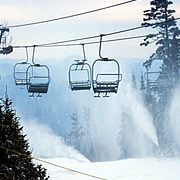By Theme:Arts and Literature | Campus Sustainability | Community Perspectives | Development | Economic Analysis | Ecosystem Analysis | Education | Energy | Environmental Justice | Food Systems | Geology of the Watershed | Green Architecture | Green Business | History of the Watershed | Invasive Species | Land Use Patterns | Public Policy | Recreation | Transportation | Water Quality
Recreation
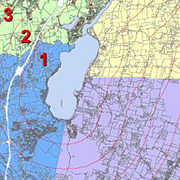 Recreation, Economic Status, and Proximity to Saratoga Lake: Saratoga Springs Residents'
Views of Municipal Water Sources
Recreation, Economic Status, and Proximity to Saratoga Lake: Saratoga Springs Residents'
Views of Municipal Water Sources
Caroline Bergelin and Jennifer Marks (2006)
We used a survey to examine Saratoga Springs residents' views of proposals to develop new municipal water sources. Analysis of survey data show that recreational activities, household economics levels, and varying distances from Saratoga Lake influence how individuals value Saratoga Lake as a key aspect of environmental and social sustainability.
 Boating and Fishing on Saratoga Lake: Stakeholders' Precieved Threats to Recreation
Boating and Fishing on Saratoga Lake: Stakeholders' Precieved Threats to Recreation
Ted Cavan, Christina Hanley, and Kate Sherman (2006)
Saratoga Lake is one of the top recreational destinations in the capital region. Our study focused on analysis of 15 semi-structured interviews of residents with a stake in boating and fishing activities on the lake. Findings include shared concerns about threats to recreation despite the lack of communication among stakeholders.
Full report is not available. Please contact Michael Ennis McMillan for more information.
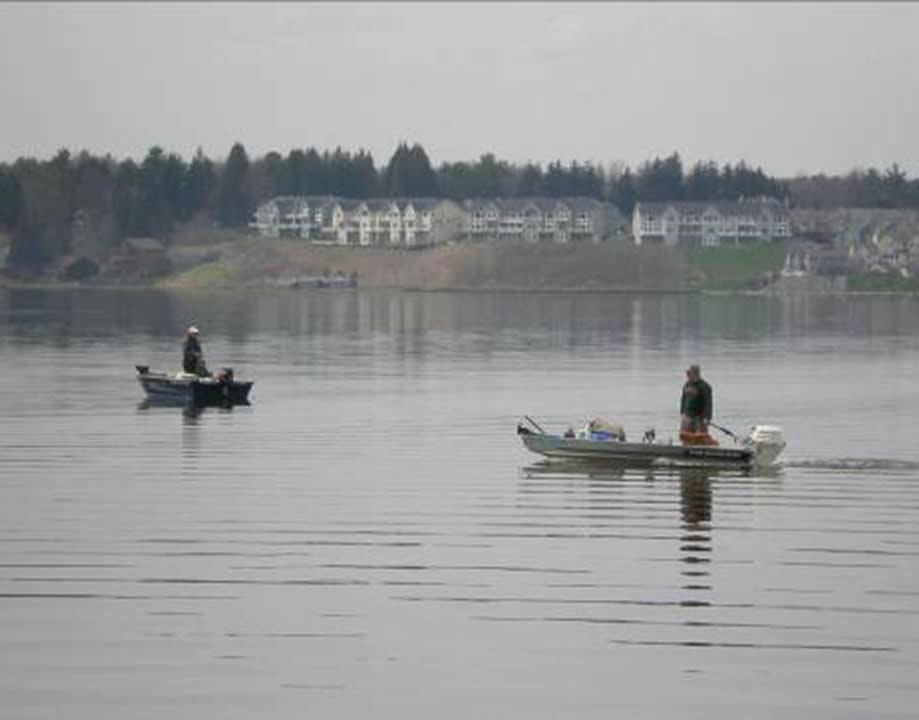 The Economic Impact of Recreation on Saratoga Lake and Threats to Its Long Term Viability:
The Perspective of Local Businesses
The Economic Impact of Recreation on Saratoga Lake and Threats to Its Long Term Viability:
The Perspective of Local Businesses
Jonathan Clarke and Peter Suneson (2007)
Much of the speculation about the use of Saratoga Lake as a drinking source has focused on its potential impact on businesses dependent on recreational activities on the lake. We surveyed owners of businesses on Saratoga Lake to derive the economic impact of recreation. We also conducted open ended interviews of business owners to ascertain what they viewed as long term threats to the vitality of the lake.
Full report is not available. Please contact Bob Turner for more information.
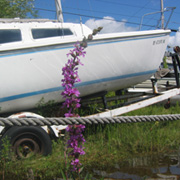 Water Conflicts and Contradictions: Recreation and Invasive Species in Saratoga Lake
Water Conflicts and Contradictions: Recreation and Invasive Species in Saratoga Lake
Molly Bergen '06, Leah Wohl-Pollack '08, Michael Ennis-McMillan, Department of Anthropology, and Karen Kellogg, Department of Biology and Environmental Studies Program (2006)
Based on over forty interviews with informed county residents, we discovered that residents' perceptions of Saratoga Lake are influenced by their desire to protect their recreational interests, representing the economic and emotional value they place on Saratoga Lake. We also learned that personal interaction with invasive species influences residents' perceptions of which species are problematic and which species management plans are desirable. Our study indicates that personal interests often overshadow environmental concern for Saratoga Lake.
Full report is not available. Please contact Karen Kellogg for more information.
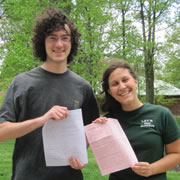 The Relationship Between Home and Nature: What Living Locations Can Tell Us About
Environmentalism
The Relationship Between Home and Nature: What Living Locations Can Tell Us About
Environmentalism
Morgan Violette and Zach Rowen (2010)
A survey of 165 residents in Saratoga County examines the link between distinct residential areas and environmental perceptions and behaviors. Residents were divided into four groups by living location: urban, suburban, rural and streams (homeowners with streams running through their property). While actions and opinions varied depending on location, the general trend is that most people in the county spend a fair amount of time recreating outdoors and are environmentally conscious.
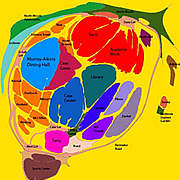 Conceptual Landscapes on Skidmore Campus: Reconciling Perception and Reality
Conceptual Landscapes on Skidmore Campus: Reconciling Perception and RealityHannah Greendorfer, Meghan Burke, and Abby Wyant (2013)
Colleges are constantly adapting to internal and external pressures. In the past ten years Skidmore College has increased in size and scope. Our project aims to illustrate how the Skidmore population views and interacts with the college campus. We investigate the conceptualizations of space using cognitive maps drawn by members of the Skidmore community. The assessment of space can then influence future developments and supports sustainable design and a strong Skidmore community.
John Crisan and Andrew Blake (2014)
The first humans to strap long pieces of wood to their feet lived during the most recent Ice Age – 8000 BC. Today, skiing has become a way of life for some and declarations of its approaching demise have caused upset. We examined historic precipitation patterns, future climate and snow cover projections, and business theory to predict the effect of climate change on ski resorts.
Full report is not available. Please contact Karen Kellogg for more information.
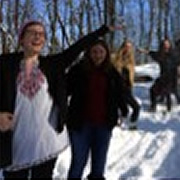 The Nature of Stress: Outcomes of Nature Walks in Skidmore’s North Woods in Relation
to Student Mental Health
The Nature of Stress: Outcomes of Nature Walks in Skidmore’s North Woods in Relation
to Student Mental Health
Jewels O’Brien, Oliver Moffat, and Laura Mindlin (2015)
Growing research supports the positive effects of interaction with the natural environment on stress, happiness, and other indicators of good mental health and cognitive functioning. We investigated the effects of three weekly nature walks on a group of college students. Our findings support the relationship between nature walks and mental health, and can inspire the modern movement towards nature-based healing, leadership, and college pre-orientation programming.
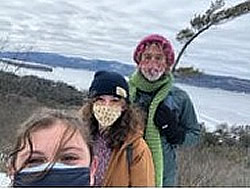 Diversity, Equity, and Inclusion in the Adirondack Park
Diversity, Equity, and Inclusion in the Adirondack Park
Olivia Berson, Andres Durante & Lucy Janovitz (2021)
We investigated diversity, equity, and inclusion in the Adirondack Park region of New York State. While the park is free and open to the public, not everyone who wants to access the Park has the ability to do so. Our research found that many programs and organizations are working to increase diversity and inclusivity in the park through education initiatives, more inclusive staff hiring and training, and efforts to make the park a more welcoming space for Indigenous communities in the region.
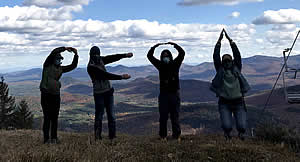 Yellow Snow Is the Least of Your Worries: The Presence and Persistence of PFOA on
Ski Hills in Upstate NY
Yellow Snow Is the Least of Your Worries: The Presence and Persistence of PFOA on
Ski Hills in Upstate NY
Jacob Adams, Gillian Brogan, Elle Ping & Sammi Smith (2021)
Perfluoroalkyl substances (PFAS) are detrimental to both human and environmental health. Many downhill ski waxes contain PFAS, as it reduces the friction between skis and snow. We collected soil, leaf, and snow samples from ski mountains in upstate NY to evaluate the presence and persistence of ski wax PFAS. Sample analyses could not sufficiently detect concentrations at or below the EPA threshold, and we could not draw definitive conclusions regarding ski wax PFAS in NY state.
Paper is not available. For information, please contact the ESS Program Director.
